Potrebujeme váš súhlas na využitie jednotlivých dát, aby sa vám okrem iného mohli ukazovať informácie týkajúce sa vašich záujmov. Súhlas udelíte kliknutím na tlačidlo „OK“.
ASTM E2837-13
Standard Test Method for Determining the Fire Resistance of Continuity Head-of-Wall Joint Systems Installed Between Rated Wall Assemblies and Nonrated Horizontal Assemblies
Automaticky preložený názov:
Štandardná skúšobná metóda pre stanovenie požiarnej odolnosti kontinuity Head-of-Wall spoločných systémov inštalovaných medzi menovitým Wall zhromaždenia a Nonrated horizontálne zhromaždenia
NORMA vydaná dňa 15.7.2013
Informácie o norme:
Označenie normy: ASTM E2837-13
Poznámka: NEPLATNÁ
Dátum vydania normy: 15.7.2013
Kód tovaru: NS-46110
Počet strán: 16
Približná hmotnosť: 48 g (0.11 libier)
Krajina: Americká technická norma
Kategória: Technické normy ASTM
Kategórie - podobné normy:
Ohnivzdornost stavebních materiálů a prvků
Stěny. Příčky. Fasády
Anotácia textu normy ASTM E2837-13 :
Keywords:
construction gap, continuity head-of-wall system, control joint, cycling , expansion joint, fire, fire resistance, fire resistive joint systems, fire separating elements, gaps, hose stream, joint, linear openings, movement, recess, separation, void, ICS Number Code 13.220.50 (Fire-resistance of building materials and elements), 91.060.10 (Walls. Partitions. Facades)
Doplňujúce informácie
| Significance and Use | ||||||||||||||||||||||||||||
|
5.1 This test method evaluates the following under the specified test conditions: 5.1.1 The ability of a test specimen to undergo movement without reducing its fire resistance rating, and 5.1.2 The duration for which a 5.2 This test method provides for the following measurements and evaluations where applicable: 5.2.1 Ability of the test specimen to 5.2.2 Ability of the test specimen to prohibit the passage of flames and hot gases. 5.2.3 Transmission of heat through the 5.2.4 Ability of the test specimen to resist the passage of water during a hose stream test. 5.3 This test method does not provide the following: 5.3.1 Any information about the 5.3.2 Evaluation of the degree by which the 5.3.3 Measurement of the degree of control or limitation of the passage of smoke or products of combustion through the test specimen. 5.3.4 Measurement of flame spread over the surface of the test specimen. 5.4 In this procedure, the
1.1 This fire-test-response test
method measures the performance of a unique fire resistive joint
system called a continuity head-of-wall
joint system, which is designed to be used between a
1.2 This fire-test-response standard
does not measure the performance of the following:
1.2.1 The rated wall assembly, which is already established by other test methods, such as Test Method E119, or 1.2.2 The nonrated horizontal assembly, which would be established by other test methods such as Test Method E119. 1.3 This fire-test-response standard
is not intended to evaluate the connections between rated wall
assemblies and nonrated horizontal
assemblies unless part of the continuity head-of-wall joint
system.
1.4 The fire resistive test end point is the period of time elapsing before the first performance criteria is reached when the continuity head-of-wall joint system is subjected to one of two time-temperature fire exposures. 1.5 The fire exposure conditions used are either those specified by Test Method E119 for testing assemblies to standard time-temperature exposures or Test Method E1529 for testing assemblies to rapid-temperature rise fires. 1.6 This test method specifies the heating conditions, methods of test, and criteria to establish a fire resistance rating only for a continuity head-of-wall joint system. 1.7 Test results establish the performance of continuity head-of-wall joint systems to maintain continuity of fire resistance of the 1.8 Test results shall not be construed as having determined the continuity head-of-wall joint system, nonrated horizontal assembly and the rated wall assembly’s suitability for use after that fire exposure. 1.9 This test method does not provide quantitative information about the continuity head-of-wall joint system relative to the rate of leakage of smoke or gases or both. However, it requires that such phenomena be documented and reported when describing the general behavior of 1.10 Potentially important factors and fire characteristics not addressed by this test method include, but are not limited to: 1.10.1 The performance of the 1.10.2 The cyclic movement capabilities of continuity head-of-wall joint systems other than the cycling conditions tested. 1.11 The values stated in inch-pound units are to be regarded as standard. The values given in parentheses are mathematical conversions to SI units that are provided for information only and are not considered standard. 1.12 The text of this standard references notes and footnotes which provide explanatory material. These notes and footnotes (excluding those in tables and figures) shall not be considered as requirements of the standard. 1.13 This standard is used to measure and describe the response of materials, products, or assemblies to heat and flame under controlled conditions, but does not by itself incorporate all factors required for fire hazard or fire risk assessment of the materials, products, or assemblies under actual fire conditions. 1.14 This standard does not purport to address all of the safety concerns, if any, associated with its use. It is the responsibility of the user of this standard to establish appropriate safety and health practices and determine the applicability of regulatory limitations prior to use. 1.15 Fire testing is inherently hazardous. Adequate safeguards for personnel and property shall be employed in conducting these tests. |
||||||||||||||||||||||||||||
| 2. Referenced Documents | ||||||||||||||||||||||||||||
|
Podobné normy:
Historická
1.4.2011
Historická
1.4.2011
Historická
1.4.2011
Historická
1.4.2011
Historická
1.12.2013
Historická
1.4.2014
Odporúčame:
Aktualizácia technických noriem
Chcete mať istotu, že používate len platné technické normy?
Ponúkame Vám riešenie, ktoré Vám zaistí mesačný prehľad o aktuálnosti noriem, ktoré používate.
Chcete vedieť viac informácií ? Pozrite sa na túto stránku.


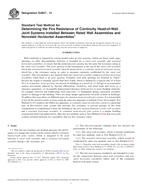
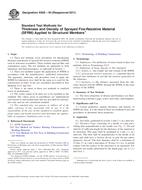 ASTM E605-93(2011)..
ASTM E605-93(2011)..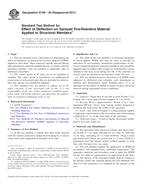 ASTM E759-92(2011)..
ASTM E759-92(2011)..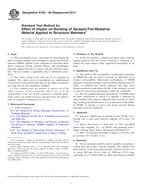 ASTM E760-92(2011)..
ASTM E760-92(2011)..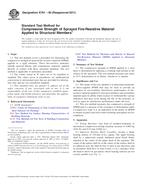 ASTM E761-92(2011)..
ASTM E761-92(2011)..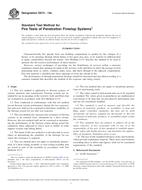 ASTM E814-13a
ASTM E814-13a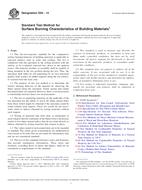 ASTM E84-14
ASTM E84-14
 Cookies
Cookies
